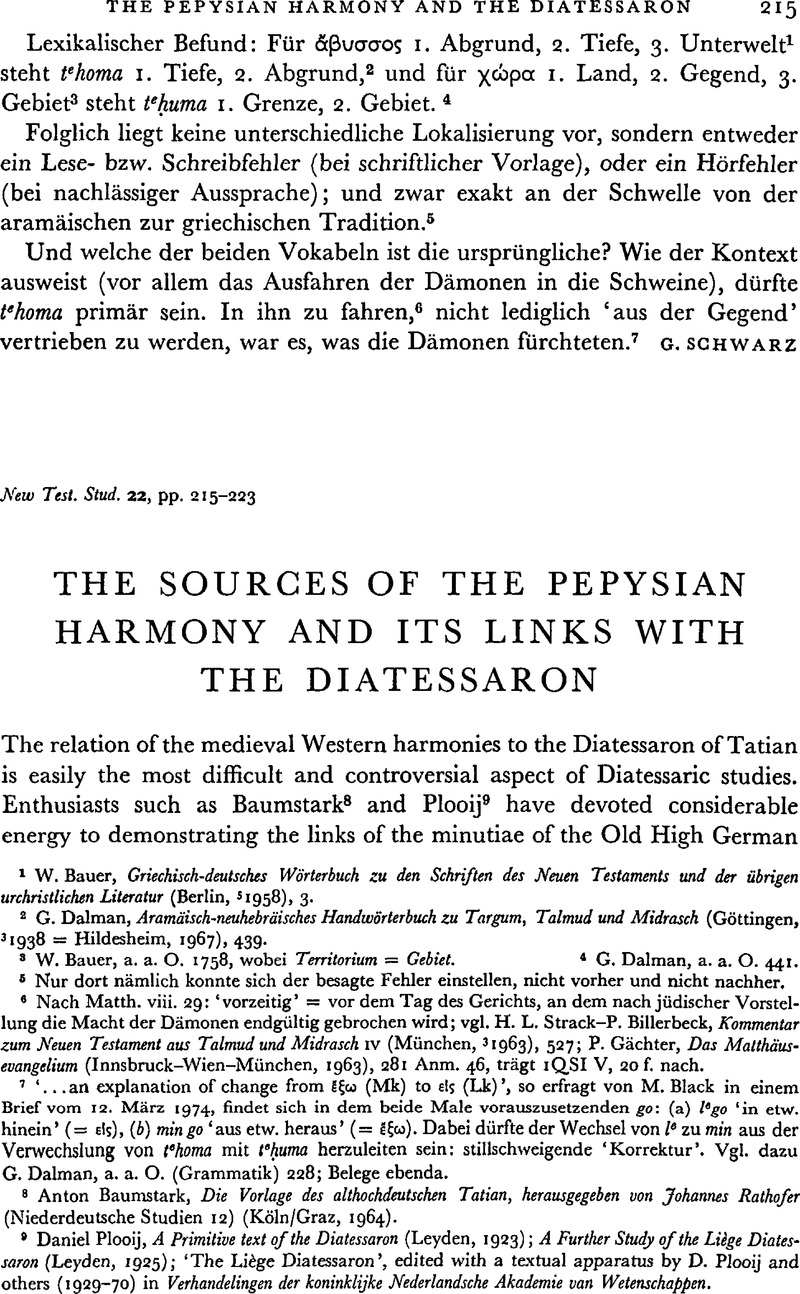No CrossRef data available.
Article contents
The Sources of the Pepysian Harmony and its Links with the Diatessaron
Published online by Cambridge University Press: 05 February 2009
Abstract

- Type
- Short Studies
- Information
- Copyright
- Copyright © Cambridge University Press 1976
References
8 Baumstark, Anton, Die Vorlage des althochdeutschen Tatian, herausgegeben von Johannes Rathofer (Niederdeutsche Studien 12) (Köln/Graz, 1964).Google Scholar
9 Plooij, Daniel, A Primitive text of the Diatessaron (Leyden, 1923);Google ScholarA Further Study of the Liège Diates-saron (Leyden, 1925);Google Scholar‘The Liège Diatessaron’, edited with a textual apparatus by D. Plooij and others (1929–70) in Verhandelingen der koninklijke Nederlandsche Akademie van Wetenschappen.Google Scholar
1 Rathofer, J., ‘Die Einwirkung des Fuldischen Evangelientextes auf den althochdeustchen “Tatian”. Abkehr von der Methode der Diatessaronforschung’ In Literatur u. Sprache im europäischen Mittelalter. Festschrift für Karl Langosch, ed. by Oennerfors, Alf and others (Darmstadt, 1973), pp. 256–308.Google Scholar
2 de Bruin, C. C., Middelnederlandse Vertalingen van hct nieuwe Testament (Groningen, 1934);Google ScholarDiatessaron Leodiense (Corpus Sacrae Scripturae Neerlandicae Medii Aevi. Series Minor. Tomus 1. Harmoniae evangeliorum. Volumen 1) (Leiden, 1970).Google Scholar
3 The Pepysian Gospel Harmony. E.E.T.S. original series no. 157 (London, 1922 (for 1919)).Google Scholar
4 The Bulletin was printed for private circulation between 1924 or 1925 and 1937 under the editorship of J. Rendel Harris. Plooij's note is in no. 2, pp. 14–16.Google Scholar
5 Ephrem, St.. Commentaire de l'évangile concordant, édité par Dom Louis Leloir (Dublin, 1963), xv. 6 (pp. 144, 145).Google Scholar
6 (Oxford, 1961), p. 21.
1 Oriens Christianus. 3te Serie, iiter Band (Leipzig, 1936), pp. 80–96. ‘Die Himmelgartner Bruchstücke eines niederdeutschen “Diatessaron”-Textes des 13. Jahrhunderts.’Google Scholar
2 P. 215, n. 9 above.
3 (Louvain, 1962) (C.S.C.O. Subsidia T. 19).
4 Op. cit. pp. xv–xviii.
5 Art. cit. (p. 216, n. 14 above), p. 15.
6 The basic work is S. Berger: La Bible française au moyen âge (Paris, 1884); for Guyart des Moulins see pp. 157–86, in Quatrième partie, La bible historiale, chapitre premier.Google Scholar
7 Migne, J.-P., Patrologia Latina, CXCVIII (1855), coll. 1045–1721.Google Scholar
8 Op. cit. p. 4, 11. 28–33.
1 Col. 1539.
2 Op. cit. (p. 217, n. 1 above), p. 87.
3 Col. 1622.
4 Op. cit. p. 10, 11. 7–11.
5 Col. 1555.
6 Op. cit. p. 8, pp. 29–31.
7 Patrologia Latina, vol. 114, col. 78.
1 Ibid. vol. 186, col. 87.
2 Zeitschrift fuer deutsche Philologie, xxi (1889), 385–90. E. Sievers, Himmelgartner Bruchstuecke. I. Bruchstuecke einer mittelniederdeutschen Evangelienharmonie, esp. p. 389 (fol. 2a), 11. 19–27.Google Scholar
3 Op. cit. p. 100, 11. 24–9, cp. Baumstark, op. cit. pp. 85 and 89.
4 Coll. 1633, 1634.
5 PH, op. cit. p. 100, 11.29–34: HB (p. 217, n. 1 above), p. 389 (fol. 2a), 11. 28, 29 (Baumstark, op. cit. pp. 85, 89): Petr. com. op. cit. col. 1634.
1 Op. cit. (p. 217, n. 3 above), pp. 118 ff.
2 Op. cit. p. 23, 11. 30 f.
3 Ibid. p. 137.
4 Ibid. p. xxxiv.
5 ME bridegoome would justify ‘époux’ (cp. NHG ‘Brautigam’, NE ‘bridegroom’).
6 Leloir, op. cit. p. 129.
7 Op. cit. p. 29, 11. 12 f.
8 Op. cit. p. 195.
9 Op. cit. p. 13, 1. 10.
10 Viz. in the Passion predictions, Matt. xvi. 21, Luke ix. 22, cp. PH, p. 57, 1. 4.
1 Leloir, op. cit. p. 200.
2 Op. cit. p. 80, 1. 29–p. 81, 1. I.
3 Leloir, op. cit. p. 79.
4 Leloir cites from the edition of Caillau (Paris, 1836), 1, 45 and 291.Google Scholar
5 Leloir, op. cit. p. 108.
6 Col. 1556.
7 See Leloir, loc. cit.
8 Leloir, op. cit. p. III PH, p. 12.
9 Leloir, op. cit. p. 121.
10 Op. cit. p. 158.
1 Op. cit. p. 228.
2 Loc. cit.
3 P. 24.
4 P. 9.
5 De consensu evangelistarum, 11. 2 (CSEL, XLIII, 84, 11. 7–11). Further instances of assertion concerning the Davidic descent of Mary (chiefly from Augustine) are as follows (I use the sigla of the file of the Vetus Latina Institut, Beuron, through which these were derived: I thank my collaborator the Rev. J. L. North, Darlington, for drawing my attention to these while working at Beuron). AU Ps 56. 3. 33 (696): ‘quia de tribu Dauid natus est unde virgo Maria quae peperit Christum’; Ps. 109. 6. 39 (1606): ‘virgo ex semine Dauid pariet filium ut sit filius Dauid: erant enim Ioseph et Maria de domo et patria Dauid’; Fau. 5. 4 (275, 2): ‘cum igitur eum evangelistae adnuntient natum ex femina de domo Dauid’: q 61. 2 (50): ‘nam et quando censiti sunt Ioseph et Maria scriptum est eos fuisse de domo, id est, de genere Dauid’: PS-AU mir. 3. 2 (2193): ‘Mariam virginem de stirpe Dauid’: AMst q 86 (147. 9–11): ‘quomodo diceretur ab idoneo teste pater ejus Dauid si non esset Maria ex semine Dauid’.
6 Op. cit. p. 10, 11. 18, 19.
7 Diatessann de Tatian, éd. Marmardji, A-S. O.P. (Beyrouth, 1935), pp. 38, 39.Google Scholar
8 PH, op. cit. p. 91, 11. 32, 33: HB, op. cit. p. 387 (fol. 1a), 11. 27–9: Diatessaron Persiano, ed. Messina, G. S.J. (Roma, 1951), pp. 336, 337, 11. 17, 18.Google Scholar
1 Drvan den Broek, R., ‘A Latin Diatessaron in the “Vita Beate Virginis Marie et Salvatoris Rhythmica”’, N.T.S. XXI (1974/5), 109–32.Google Scholar


